How to Create a Sensory Room for Children with Autism
Equipment & DIY ideas on a budget

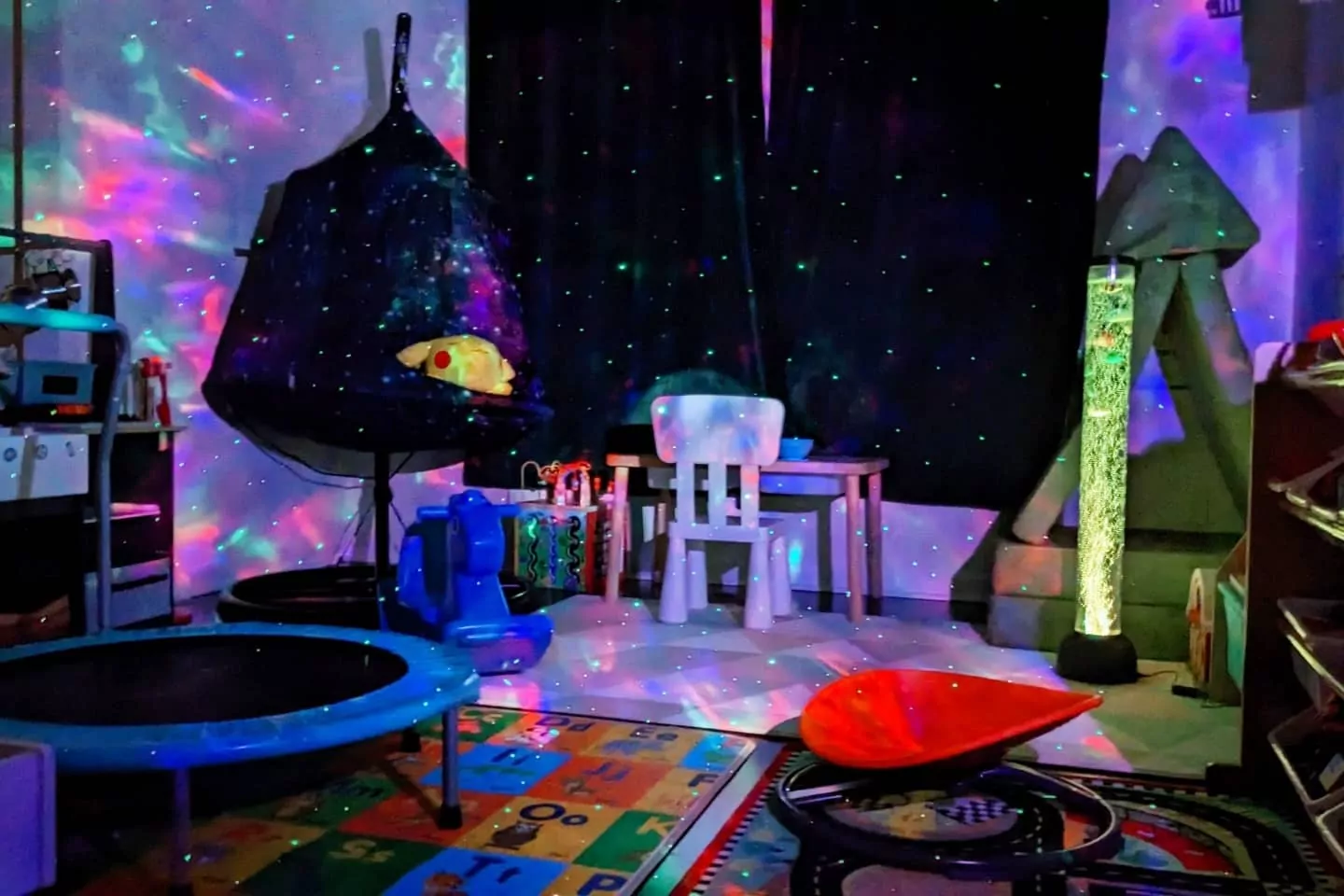
Imagine a place filled with safe, engaging, and educational activities for your child with autism.
Image a place where your child wants to be…and a place that is rewarding to visit.
Now, imagine that this place is located in your own home. This place is called an autism sensory room.
A sensory room for autism is a controlled environment where people with sensory processing issues (like autism) can play, learn, and explore various sensory stimuli. These rooms help to increase focus, relaxation, and regulation of sensory input.
Parents and teachers have started designing and utilizing sensory rooms to promote the well-being of autistic children.
How to create a DIY autism sensory room
Building a sensory room in your home can be a rewarding project. There are numerous benefits for families with autistic children. While some rooms contain expensive high-tech gadgets, others are done on a budget.
I’ll outline ideas and strategies below to get you started with any space or budget.
1. Plan your room’s purpose
Every child with autism has unique needs, strengths, and weaknesses.
Before investing time and money creating a sensory room, develop goals for the space.
Ask yourself: Will my child benefit more from calming sensory activities, exercises in an active space, or a mix of both? For example:
| Family description | Ideal activities |
| Family A has a hyposensitive child. | Hyposensitive kids seek sensory input. Healthy activities for sensory seekers include: tunnel crawling, jumping rope, bouncing on a trampoline, dancing, swinging, or rolling an exercise ball. |
| Family B has a hypersensitive child. | Hypersensitive kids overreact to sensory input. Playing with sand or dough, lifting weights, moving heavier items, listening to soothing sounds, and deep pressure activities help them integrate sensory input better. |
By considering what sensory stimuli are most important for your child, you can be more intentional with purchasing equipment and setting up the space.
2. Decide on a location
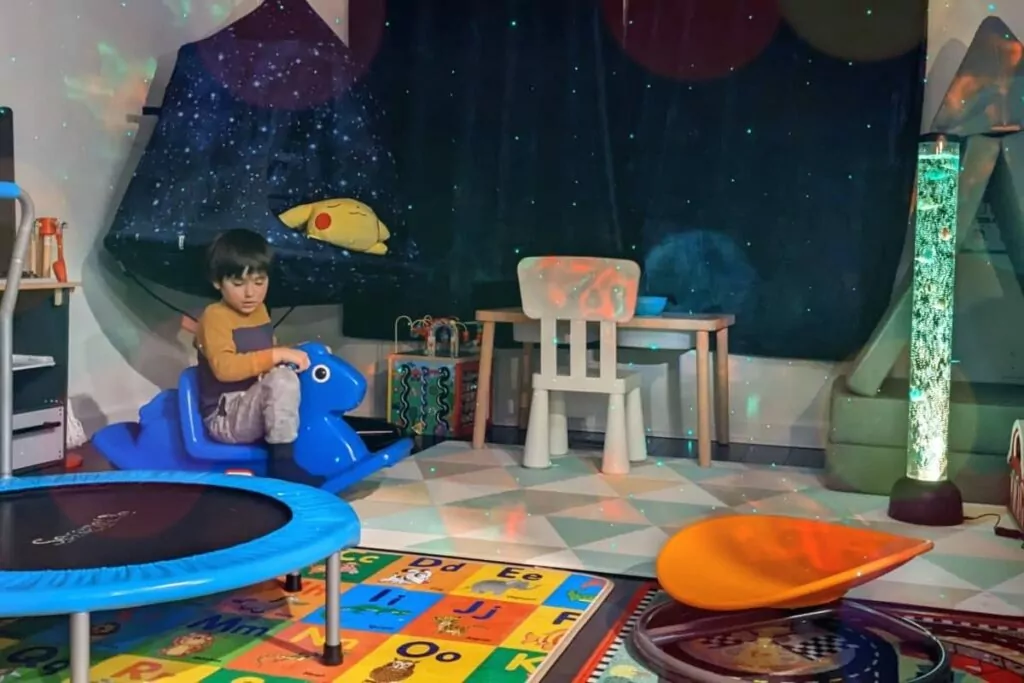
Next, consider the available spaces where you can put a sensory room in your home. Will you have a dedicated space (like a converted playroom)? Or, will you use the area for multiple purposes?
You can create a sensory area in your home, regardless of how much space you have.
Tip! If your space is limited, consider designating a corner of any room as a “sensory play area” with a special carpet or rug. You can store most sensory items in a nearby closet. The area can even double as your exercise room or office space.
While there is no “right” place to put a sensory room, it’s not ideal to place the sensory equipment in your child’s bedroom.
Ideally, the sensory area will be a special, safe location used only during appointed times. Thus the bedroom will remain the “sleep area,” and the sensory space will be the set “play area.”
3. Set your budget
Next, decide what you want to spend on the sensory room project.
Do you want to spend money buying high-tech gear and furniture? Or will you find cheaper items for designing the room on a budget? Some people spend thousands of dollars, while others spend hundreds.
The average investment for a sensory space ranges from $500 to $5,000 or more.
| Budget type | Equipment type |
| Larger budget | Higher-priced items could include a sound system, unique light fixtures, new flooring, professional installations, and equipment marketed as “sensory-friendly.” |
| Smaller budget | If you opt for DIY solutions, creating the room will be cheaper. Options include repurposed items, second-hand items, and buying more generic toys or objects from large online retailers. |
4. Plan organization and design choices
Once you have a purpose, location, and budget, you can start thinking about organization and design. Consider:
- Placement. Where will I put more oversized items, like a trampoline, a sensory swing, or other furniture? Will I set up “stations” for different types of activities?
- Cleanliness. How will I keep the space or corner clean and free of clutter? Will I have bins to organize smaller items and toys? Will I rotate activities in different stations?
- Aesthetic. How will the room look? Will I place anything on the walls? Does my child enjoy brighter or muted colors?
- Large renovations. Will I be doing any significant renovations? Big projects include installing carpet, making the room soundproof, updating window fixtures, and painting.
- Safety. How can I remove sharp edges, corners, or other dangerous items?
An excellent strategy to visualize your sensory room at this stage is to use a room planner or create a mood board with Pinterest, Canva, or poster board.
5. Start purchasing equipment
Now you’re ready to begin making purchases.
While you can purchase items in any order that makes sense, starting with larger purchases is a good idea. This way, you can begin with the essentials and add smaller items over time.
Tip! Buying anything marketed explicitly as “sensory-friendly” might come at a higher cost than a generic item used for the same purpose.
Here are places you can buy items for your sensory room:
- Amazon. Start your search with queries like “sensory room items” or “sensory room” on Amazon.
- Small online companies. Check out smaller companies like Special Needs Toys, where you can order furniture, equipment, and toys. Consider filtering from price: low to high, as some items cost thousands of dollars.
- Local retailers. Finally, look at shops in your area. These can range from big box stores like Target or Walmart to smaller toy shops.
6. Set up and start using the room
Finally, you are ready to begin setting up and using the sensory space.
It’s good to remember that this space is a work in progress. You can always add items that you find and remove items that don’t work.
Additionally, many parents get help from the whole family when setting up the sensory room. Enlisting help is not only fun, but it also reduces the chance of sensory overload once the room is set up.
For example: Your child with autism might do DIY crafts with you, paint walls, give advice about what they like and don’t like, shop with you, and overall take ownership in the process.
Benefits of a sensory room for autism
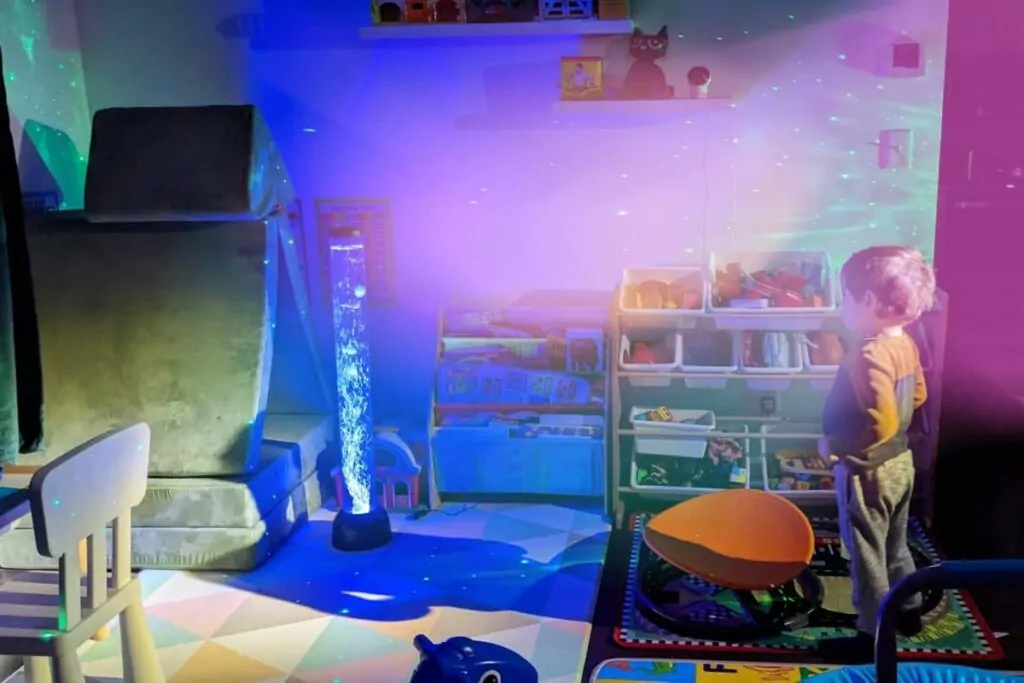
A sensory room can benefit families and children with autism by promoting the following:
- Healthy sensory experiences. Sensory overload and hypersensitivity are typical for children with autism. A break in the sensory room can balance this overload, leading to reduced overreactions, less harmful stimming, and better self-regulation.
- A positive home environment. A sensory room boosts behavior management. The room can function as a reward, a location for at-home therapist or teacher visits, and a place where you can bond with your child through play.
- Better sleep and routine management. Children with autism thrive with a consistent routine. Playing with sensory objects before bed or upon waking can help autistic children feel calm, in control, and relaxed.
- Increased social communication and development. Sensory play can act as a “social glue” for autistic children with communication issues. Using the room with a trusted person (a friend, parent, therapist, or teacher) is a low-stakes method to develop social and communication skills.
- A focused mindset. Playing with sensory-friendly objects primes the mind for learning. For example, if a child spends time in the sensory room before attending school, they will be more engaged and comprehend lessons better.
- One Grand Valley State University study found that “on average, students were 56% more engaged in classroom activities post-sensory room intervention.”
The best equipment to place in a sensory room
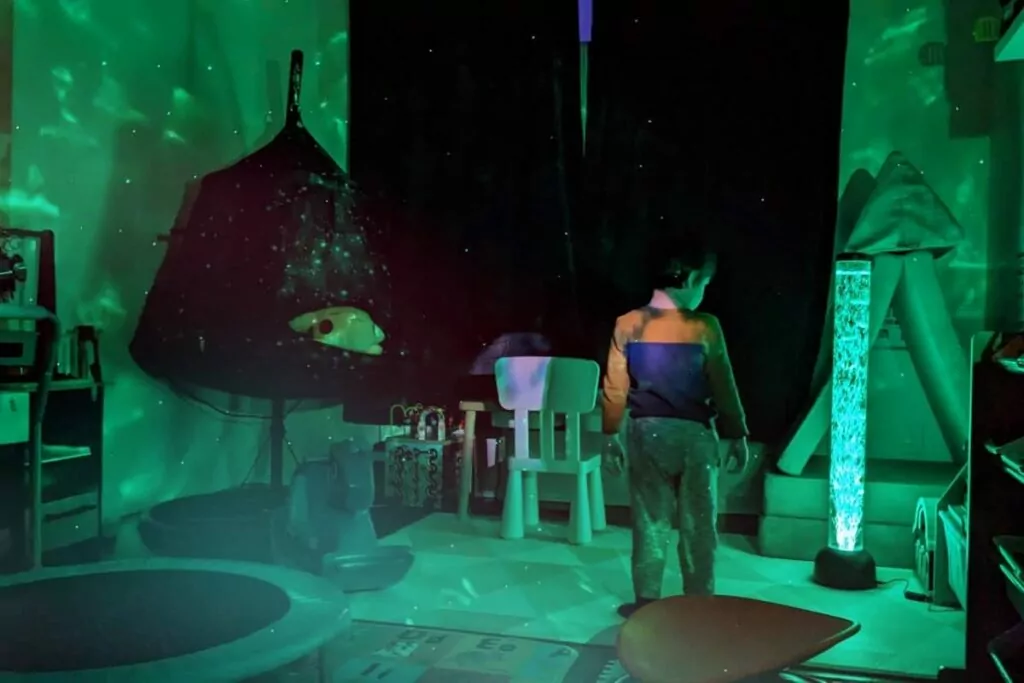
All items in a sensory room engage one (or more) of the senses. Depending on your child, you might get a mix of all types of equipment, or you may target one sense in particular.
| Sense engaged | Equipment and activity ideas |
| Vestibular (motions like rocking, turning, moving, twisting, and spinning; the sense of balance) | Hammock Rocking horse Moon shoes Pogo stick Bosu ball Walking path (also called a sensory path) Games like charades, Twister, Freeze, Simon Says, and musical chairs) |
| Proprioception (crashing, pulling, lifting, jumping; the feeling of body in space) | Weighted items (toys, blankets, and stuffed animals) “Deep pressure corner” (snuggle space with blankets and animals) Trampoline Exercise ball Pop-up tubes Heavy items to pull or push Resistance bands or rope swings Jumping rope Fidget toys Crash pad |
| Tactile (sense of touch) | Textured pillows or materials Felt board Sensory wall Painting Play Dough (or slime) Water beads |
| Visual (eye contact, looking at or avoiding bright lights, and looking at moving objects) | Twinkle lights (soft or pastel-colored) or holiday lights Fiber-optic lights Colored fabrics to place over fluorescent lighting or bright lights Lava lamp Bubble lamp Any lighting that is natural and diffused (not reflective) Fake candles Glow sticks Projector |
| Gustatory (sense of taste) | Chewing gum and blowing bubbles Do a “trying time” with new foods |
| Aural (hearing sounds and music) | Soothing sounds (like rain) from a stereo or headset Carpeted floor for sound absorption Noise machine (white, brown, or pink noise) Noise-canceling headphones Musical toys (this is also tactile) |
| Olfactory (sense of smell) | Washed toys and materials without irritating fragrances or chemicals Well-ventilated room Aromatherapy or essential oils (especially lavender for relaxation) |
Frequently asked questions
What do you put in a sensory room for an autistic child?
A sensory room should have soft furnishings, sensory toys, soothing music, and pleasant, soft lighting. Popular sensory items include weighted blankets, crash pads, fiber-optic lights, lava lamps, exercise balls, textured toys, trampolines, and projectors.
Why do sensory rooms help children with autism?
Sensory rooms help children with autism because they are safe, calm environments for sensory engagement. After visiting the space, autistic children are less stressed, less anxious, better able to learn, and more self-regulated.
Reader submitted sensory room photos
Travis recently put together a sensory room for about $500, including a swing, wedge ramp, crash pad, light show, and some sensory boards.
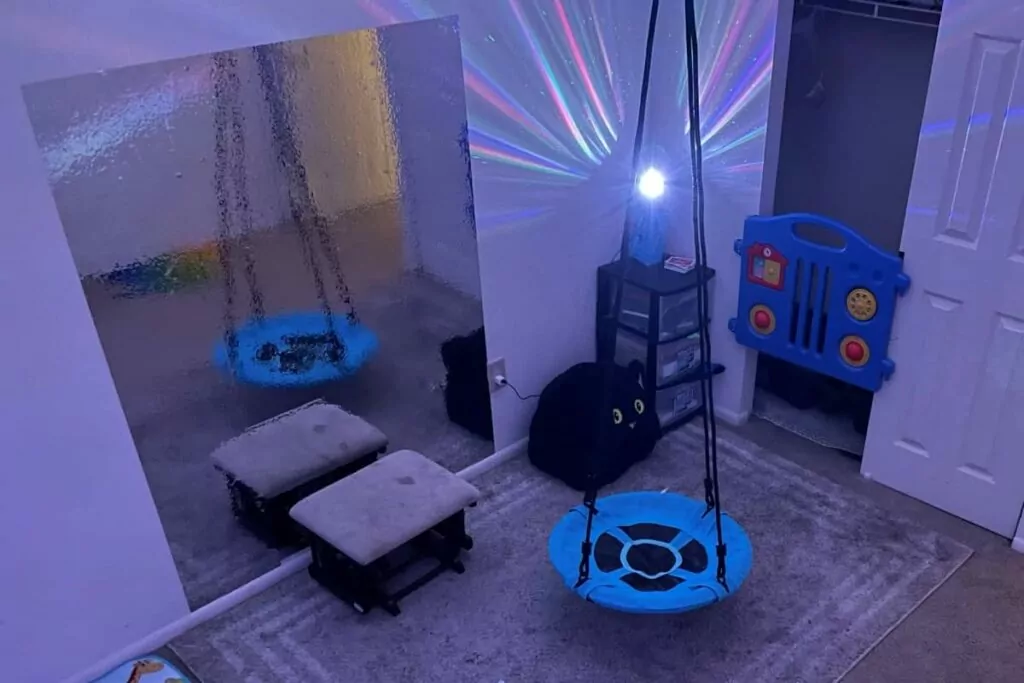
Final thoughts
A sensory room for autism is a valuable learning and behavioral tool.
Children with autism can use the room to regulate sensory input, prepare to learn, and manage stress and anxiety. While high-end sensory rooms can be costly, many budget-friendly options exist for all families.
Overall, sensory rooms can significantly improve daily life and routine management for children with autism and their families.
Written by Clancy Giesbrecht

Clancy Giesbrecht is an English teacher with a special education certification. She teaches students with various special needs, including autism. She helps students by providing a consistent routine, teaching social skills explicitly, and keeping in mind how much sensory input students receive at one time. She provides individualized accommodations and scaffolds for each student to promote maximum growth based on strengths and weaknesses. She graduated in 2017 from Pepperdine University in Los Angeles before moving to Lubbock, TX. When she’s not grading papers or writing, she enjoys traveling with her husband, walking her dogs, reading fantasy novels, and playing board games.
